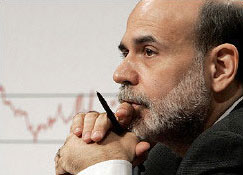 Ben Bernanke will be confirmed by the Senate for a second term as Fed Chair, but the market is already jittery that it won’t happen by the end of his term at midnight, January 31. That has set off quite a behind-the-scenes debate whether Fed Vice Chair Don Kohn would take over temporarily until the Senate voted. Kohn would be as good a temporary replacement as they come, but I can assure you that the markets would plunge on February 1st anyway. I believe this will all be moot when the Senate votes just in time, but Senate leadership staff confirm that no vote has been scheduled yet.
Ben Bernanke will be confirmed by the Senate for a second term as Fed Chair, but the market is already jittery that it won’t happen by the end of his term at midnight, January 31. That has set off quite a behind-the-scenes debate whether Fed Vice Chair Don Kohn would take over temporarily until the Senate voted. Kohn would be as good a temporary replacement as they come, but I can assure you that the markets would plunge on February 1st anyway. I believe this will all be moot when the Senate votes just in time, but Senate leadership staff confirm that no vote has been scheduled yet.
The confusion over Bernanke’s continuation as Fed Chair arose on December 17, 2009, when Senate Banking Chair Chris Dodd (D-CT) had this exchange with Senator Jim Bunning (R-KY) toward the end of the Committee meeting which voted 16-7 to nominate Ben Bernanke for another term as Fed Chair:
BUNNING: Briefly.
It’s my understanding that what you have said about Chairman Bernanke after the 30th of January is incorrect.
DODD: Well, I’ll defer to staff. I raised the question, I was told that was the issue, that he could be a member of the board, but could not serve as chair of the Federal Reserve.
BUNNING: Temporarily appointed as chair?
DODD: The vice chair would serve.
Bunning remembered, as does the market, that Alan Greenspan served as “Chairman Pro Tempore” beyond the expiration of his term from March 3, 1996 to June 20, 1996. The Fed web site also shows Marriner S. Eccles served from February 3, 1948 to April 15, 1948 after the expiration of his term. In neither case did the Vice Chair step in.
Fed and congressional attorneys are still debating this.
Here are the operative paragraphs from Section 10 of the Federal Reserve Act:
From Paragraph 2:
“Of the persons thus appointed, one shall be designated by the President, by and with the advice and consent of the Senate, to serve as Chairman of the Board for a term of four years, and one shall be designated by the President, by and with the consent of the Senate, to serve as Vice Chairman of the Board for a term of four years. The chairman of the Board, subject to its supervision, shall be its active executive officer. Each member of the Board shall within fifteen days after notice of appointment make and subscribe to the oath of office. Upon the expiration of their terms of office, members of the Board shall continue to serve until their successors are appointed and have qualified.”
From Paragraph 4:
“At meetings of the Board the chairman shall preside, and, in his absence, the vice chairman shall preside. In the absence of the chairman and the vice chairman, the board shall elect a member to act as chairman pro tempore.”
The issue is whether “absence” is physical absence or absence from the chairmanship despite Paragraph 2’s proviso that Board members (but not Chair’s?) shall serve until their successors are appointed
This will be moot in my opinion because the Senate is likely to vote to confirm Mr. Bernanke before the end of this month despite the “holds” placed on his confirmation by Senators Bernie Sanders (I-VT), Jim Bunning (R-KY), David Vitter (R-LA), and Jim DeMint (R-SC). Holds are an informal practice by which Senate leaders agree not to bring up legislation without informing the objecting senator, who may filibuster when it is brought up. As this Senate explanation shows, holds are NOT BINDING. The Majority Leader can still bring up the legislation upon notifying objecting senators. If a filibuster arises, 60 votes would be required to take it up.
The Senate first confirmed Mr. Bernanke as Fed Chair by a voice vote on January 31, 2006, the very last day of Alan Greenspan’s long tenure, with only Senator Jim Bunning (R-KY) speaking in opposition. Although Mr. Bernanke has attracted a few more opponents this time around, I’d be very surprised if 60 votes can’t be found to confirm him for another term before the end of January.
Disclaimer: This page contains affiliate links. If you choose to make a purchase after clicking a link, we may receive a commission at no additional cost to you. Thank you for your support!



Leave a Reply